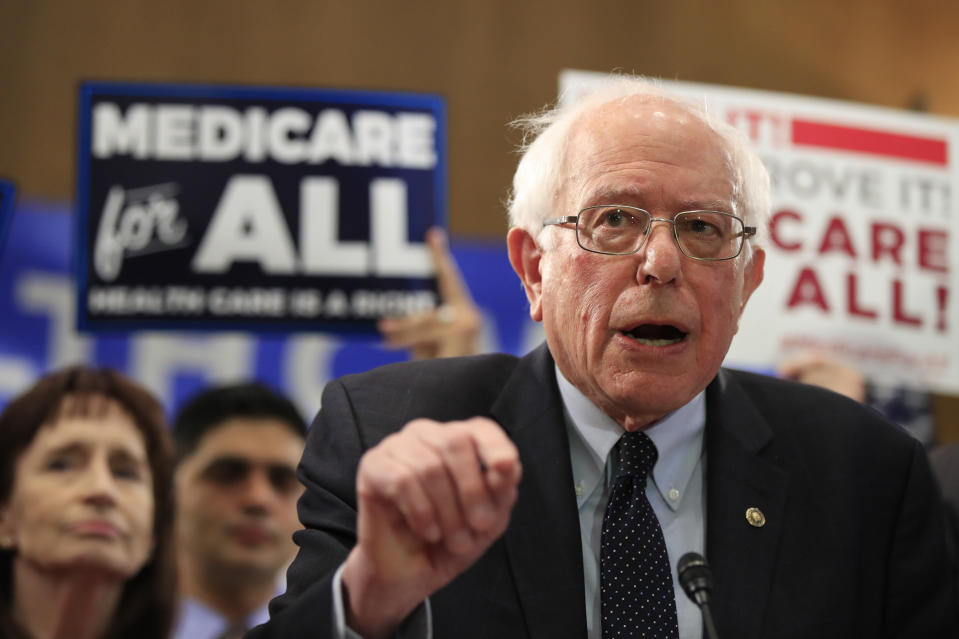What’s really new about 'Medicare for all'

Democratic Sen. Bernie Sanders has a new and improved version of his Medicare for all plan. His vision for government-run health care for every American now includes long-term care for seniors and the disabled, and a few other tweaks. The 2020 presidential candidate also proposes some general ways to pay for the costly plan, such as new taxes on the wealthy, big banks and some other businesses.
The bigger news, however, is that Medicare for All now has a lot of competition. With health care continuing to be a top voter concern, Congressional Democrats have rolled out a range of proposals for making care cheaper and easier to obtain, without the huge tax hikes and massive disruption – and voter heartburn – Medicare for all would entail.
Sanders’ MFA plan—supported by at least 7 other presidential candidates—would eliminate the private insurance system through which 175 million Americans get coverage. Employers would no longer provide insurance for their workers, with everybody moving into the government plan. A surge of newly covered patients could stress the system and create long waits for some care. Doctors would get paid less, which might draw some would-be caregivers into other fields. Nobody knows if patients would be able to keep their doctors or be forced to see whoever’s available.
A Sanders-style plan would boost federal health care spending from $1.1 trillion per year to 3.5 trillion per year, according to a new analysis from Rand. That would require big tax hikes. But employers and individuals would no longer pay for health care, and it’s possible the nation might get more bang for the buck from a single national program with enhanced purchasing power. Still, the transition to a national program would produce many losers—starting with millions of insurance-company workers and others who’d lose their jobs—which makes the idea politically explosive and probably untenable.
More options
But there’s also a bill called the Medicare X plan that would establish a new federal plan for people who can’t find affordable private-sector coverage, while leaving the employer-sponsored market alone. Enrollees would pay premiums covering most of the cost, with no need for major tax hikes. The Choose Medicare Act would create a new program called Medicare Part E for anybody who doesn’t currently qualify for a federal program, which would also leave the private system in place and require enrollees in the new program to pay premiums. Another plan would let states offer Medicaid to anybody, with enrollees above certain income threshold paying premiums.
The Commonwealth Fund, which tracks health care legislation, counts at least 11 Congressional proposals for moving toward universal coverage that includes everybody. Only four of those call for a huge single-payer system. And one of those, unlike the Sanders plan, would require enrollees to pay premiums or co-pays, to help cover the cost.
The other seven plans would leave most or all of the current system in place, while seeking to expand coverage or lower costs through more government options. That approach seems more politically feasible, since in general it wouldn’t require people who like their current coverage—whether public or private—to give it up.
All of these proposals come from Democrats. There is no Republican plan for universal health coverage, and the party seems lost on the issue after trying and failing to repeal the Affordable Care Act in 2017, when Republicans controlled both branches of Congress and the White House. The Trump administration is still trying to kill the ACA, by joining a lawsuit claiming the ACA is invalid now that Congress has lowered the penalty for failing to get insurance to $0. Legal experts say the suit will probably fail. But if it doesn’t, the Trump administration has no backup plan and popular provisions of the ACA, such as a ban on insurance exclusions for pre-existing conditions, will disappear.
The time wasn’t right for another big health-care reform effort in 2016. The ACA was still highly controversial and voters, in electing Trump, decided to give a private-sector businessman a shot at something other than government solutions. Trump has done nothing on health care, and an improving economy hasn’t solved the health care affordability problems. So health care will be on the ballot in 2020. And Medicare for all may not end up the front-runner.
Confidential tip line: rickjnewman@yahoo.com. Encrypted communication available. Click here to get Rick’s stories by email.
Read more:
Business taxes hit a record low under Trump
Why Trump wants to manipulate the Federal Reserve
The Mueller probe was money well spent
College admission scandal reveals the worst parents ever
Why voters will reject the "Green New Deal"
3 problems with Elizabeth Warren’s wealth tax
Rick Newman is the author of four books, including “Rebounders: How Winners Pivot from Setback to Success.” Follow him on Twitter: @rickjnewman
